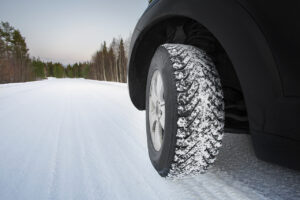Winter tires – improved braking? Really?
The early season snow is a sure signal that winter is just around the corner and for many, that means, getting those winter tires installed. After all, getting your vehicle stuck in the snow is no fun, and snow tires can make the difference on that snowy road! But what if those same winter tires could possibly save you from a fender bender? Thanks to tread pattern technology and rubber compound advancements, winter tires can actually improve handling while reducing stopping distances! Since your tires are your only contact points with the road, it’s worth understanding a little more about snow tires.
At ISL Insurance, we’re committed to not only saving you money on insurance but your safety. That is why we want to share some important winter driving information that might just help prevent you from getting into an automotive collision this winter.
Snow tires can save money? – it’s true. The improved safety, handling and braking features may save you thousands by preventing a nasty fender bender.
Modern winter tires have improved tread patterns which clear snow better, thanks to computer-aided design. This results in better traction and braking. However, the real magic of new snow tire technology comes from the use of softer rubber compounds. They stay pliable in colder weather, helping to grip ice while reducing braking distances. The math is simple – a shorter stopping distance can often be the difference between sliding into that snowbank or not.
But I have an all-wheel-drive vehicle, do I really need winter tires?
While it’s true that 4X4 and all-wheel drive systems do give drivers more traction, they still rely on the composition of their tires to provide grip to function effectively. If your tires don’t provide that level of traction, the system is rendered essentially useless. All-wheel-drive is designed to help you accelerate, not stop.
Winter tires work with your all-wheel-drive system to improve overall safety in winter conditions. They enhance your control which means better acceleration and perhaps more importantly better-stopping power.
Winter tires improve your braking
All-season tires are great in inclement weather such as rain and off-road conditions like mud. Unfortunately, they are not designed to handle the snow or cold as well as winter tires. Most all-season tires start to harden and lose elasticity at around 7°C. As the temperature drops, these tires will continue to lose grip. At around -15°C, the tires will have lost all elasticity. That means your all-season tires will have little to no grip, affecting your vehicle’s traction and braking. In wet, snowy, or icy conditions your all-season tires will require longer braking distances to avoid collisions.

Winter tires, on the other hand, are manufactured with a unique rubber composition that allows them to remain soft enough to grip the road. They only harden at around -40°C which provides drivers with more traction, even in extreme weather. Additionally, the winter tires feature special tread that is specifically designed for the snow. The wider grooves commonly found on winter tires allow snow to clear the treads.
The softer rubber grips the road better and can shorten braking distance by as much as 25% according to the Ontario Government.
Are winter tires required by law in Ontario?
Unlike in some other provinces, Ontario does not mandate the use of winter tires. The Government of Ontario does recommend their use.
Can I use my winter tires all year?
The unique composition that makes them ideal for cold environments also makes them more susceptible to wear and tear in temperatures above 7°C. The softer rubber will wear more quickly in the spring and summer months. leading you to have to replace your tires more often. It is recommended to remove your winter tires as the temperature begins to rise and store them.
When is the right time to change your tires?
Experts recommend waiting until the ambient temperature is below 7°C. Below this temperature, summer and all-season tires become hard and lose their ability to adequately grip the road. Winter tires are designed with a different composition that allows them to remain soft and grip the road even in cold temperatures.
Following the same logic, as the temperature begins to climb, at the end of winter you should get your winter tires removed. If the ambient temperature is over 7°C, your winter tires no longer offer a performance advantage and in fact, will begin to wear faster. Getting them removed as soon as it is warm enough will help prolong their life.
Keep in mind some insurance companies also have set dates for which the tires have to be installed. Our recommendation is November 1 to April 1, but dates may vary so be sure to check with your provider.
Does having winter tires affect my insurance?
All insurance providers are required to offer a winter tire discount although the exact amount will vary. If you have invested in new tires, be sure to update your insurance provider. If you have more questions on how winter tires may save you money on your insurance please contact us.


